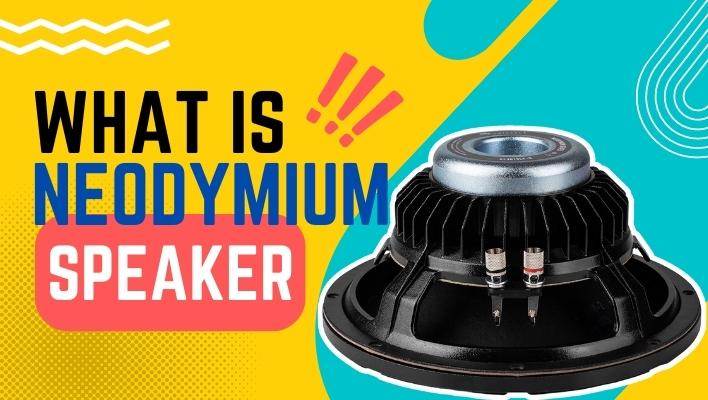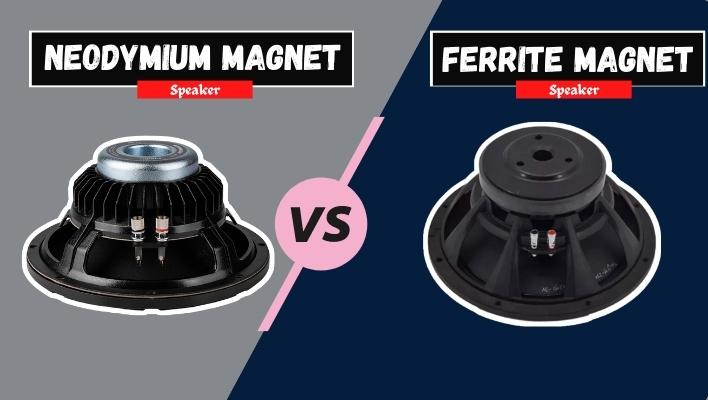When it comes to sound quality, there are two schools of thought: those who believe in the power of neodymium speakers and those who swear by ferrite speakers. So, which is better?
Whether you’re trying to pump up the bass for a party or looking for a high-fidelity sound, you have many speaker options available that can deliver impressive results. Two of the most popular choices are ferrite speakers and Neodymium loudspeakers.
Ferrite and neodymium speakers work by converting an electrical signal into sound. The main difference between them is the type of magnet used in the construction of the speaker.
In this blog post, we will explore the differences between ferrite and neodymium speakers to help you decide which one best fits your needs. Discover their related advantages, drawbacks and applications, so you can determine which type of speaker is right for your project or performance space. But before we talk about that, let us first understand what is the role of magnets in speakers.
Role of Magnets in Speakers
Magnets play an important role in the making of speakers. They work by creating a magnetic field that moves the speaker cone back and forth, creating sound waves. The magnet concentrate the electric current from the amplifier, which is then converted into sound. The stronger the magnet, the louder and clearer the sound will be.
The magnet could be made from either ferrite or neodymium. It creates a constant magnetic field around the conical voice coil attached to the back of the diaphragm within each enclosure.
But why do subwoofers have magnets? Let us find out!
Why Do Subwoofers Have Magnets?
Subwoofers are speakers specifically designed to produce low-frequency sounds, such as bass and sub-bass. They are usually larger than regular speakers, and are placed near the main speakers to fill in the bottom end of the sound spectrum.
Subwoofers come with larger drivers (speaker cones) that require more powerful motors capable of producing deep bass frequencies (20-120 Hz).
To do this effectively requires stronger permanent magnet motors, such as those found in both neodymium and ferrite subwoofer systems. These drivers must move quickly enough so that low-frequency sounds can travel across large distances without losing their intensity or clarity.
Using larger permanent magnets helps generate enough force for this level of performance.
Neodymium Magnet Speakers vs Ferrite Magnet Speakers
As discussed above, the two most common types of magnets used in audio speakers are ferrite and neodymium. Let us now explore the differences between them to determine which is best suited for a range of audio applications.

What Is a Ferrite Speaker?
A ferrite speaker is a type of magnetic transducer that uses a permanent magnet made from an iron-based material to create an electro-magnetic field when current passes through it. This electromagnetic field causes the diaphragm to vibrate, which then produces sound waves.
Ferrite speakers are typically used in small devices such as portable radios or laptop computers due to their relatively compact size and low cost.
Advantages of Ferrite Speakers
- Ferrite magnets are made of iron and other metals such as barium and strontium. They are strong, durable, and relatively affordable, making them an ideal choice for budget-minded consumers.
- One of the main advantages of using a ferrite speaker is its low cost compared to other types of speakers. They are unique in that they generate sound through the use of a permanent magnet, instead of an electromagnet. This means that ferrite speakers are very efficient, producing energy in the form of sound with a minimal amount of power input.
- Also, ferrite speakers typically have good frequency response and distortion characteristics, meaning they can be used for music reproduction as well as speech transmission applications.
- Finally, since ferrite speakers do not require any special wiring or installation procedures, they can be easily installed in any type of device with minimal effort and time investment.
Disadvantages of Ferrite Speakers
Ferrite speakers tend to be less efficient than neodymium speakers, meaning they don’t produce as much sound per watt. This can lead to a muddier, less defined sound.

What Is a Neodymium Speaker?
Neodymium speakers use rare-earth magnets made from neodymium and other elements instead of iron-based materials like ferrite magnets. Instead of producing an electro-magnetic field when current passes through it, neodymium magnets generate a permanent magnetism in the speaker itself without needing any external power source.
This allows neodymium speakers to produce higher sound levels with less distortion than ferrite speakers while still being able to maintain good frequency response characteristics.
Advantages Of Neodymium Speakers
- The primary advantage of using neodymium speakers is that they offer significantly better performance than traditional ferrite models in terms of both power handling capabilities and maximum SPL (Sound Pressure Level). This makes them ideal for high-end professional audio applications. Studio monitoring and live music venues, in particular, benefit from their superior sound quality despite the lack of portability or cost savings.
- Additionally, neodymium drivers are much more efficient than ferrites due to their powerful permanent magnet design. So they require less energy input to achieve similar volume levels as compared with other types of drivers.
- Finally, neodymium drivers weigh less than ferrite models, so they don’t put a strain on amplifiers. This allows amplifiers to power them for longer periods without overloading components.
Disadvantages of Neodymium Speakers
The main disadvantage of neodymium speakers is their cost. Compared to ferrite speakers, neodymium speakers are usually much more expensive and harder to find. This makes them less attractive for budget-conscious buyers.

Applications Of Ferrite Vs Neodymium Speakers
Ferrite and neodymium speakers can both be used for various applications. The type of performance and budget restrictions will determine which is best for a particular project. For example:
- Home Theater Systems: Ferrites can provide adequate sound quality at lower cost, whereas larger Neos may produce better overall home theater experience but come at higher prices.
- Portable Audio Devices: Portable devices such as smartphones and laptops that need loud volume levels but don’t need the highest quality audio reproduction can benefit from the use of cheaper ferrite magnets. However, if better overall acoustics is desired, then Neo drivers would yield better results
- Recording Studios: Here Neos again come out ahead with their superior dynamic range & low distortion to mix individual tracks with greater accuracy
- Live Music Venues: For larger venues, Neo’s can provide full coverage & high SPL’s while still maintaining excellent clarity & definition across all frequencies.
Conclusion
When deciding between ferrite vs neodymium speakers for your audio setup, there is no clear winner. It will ultimately come down to personal preference based on what factors you prioritize when making your purchase decision.
Ferrite and neodymium speakers both have their advantages and disadvantages. Ferrite speakers are usually cheaper and have a higher power handling capacity, but have poorer sound quality. Neodymium speakers are usually more expensive and have lower power handling capacity, but have better sound quality. Ultimately, the choice between ferrite and neodymium speakers is up to you and your audio needs.
